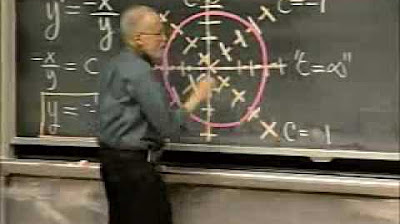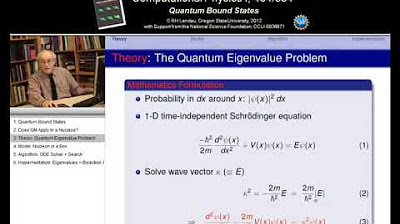19.2 Electrostatic PDEs I
TLDRThis lecture series introduces various methods for solving partial differential equations (PDEs), crucial in engineering and physics. The focus is on numerical solutions, which are often more accessible than analytic ones. The lecturer presents a simple relaxation technique for solving PDEs, suitable for undergraduates in computational physics. The example of finding the electric potential within a conductor with given boundary conditions is used to illustrate the process. The limitations of traditional Fourier analysis are discussed, and the benefits of numerical methods, such as finite differences, are highlighted.
Takeaways
- 📚 The lectures will cover various types of partial differential equations (PDEs) and their solution methods, highlighting their importance in engineering and physics.
- 🔍 Analytic solutions to PDEs can be challenging to find, whereas numerical solutions are often more straightforward, reliable, and fast.
- 🛠 The relaxation technique introduced is simple and suitable for basic problems, but more robust algorithms may be needed for complex industrial applications.
- 🌐 The primary problem presented is to solve for the electric potential within a conductor with arbitrary geometry and boundary conditions.
- 🏗️ The assumptions made for the problem include a closed region with no potential outside the box and a conductor with an equal potential across its surface.
- 📉 The script discusses the limitations of using Fourier series for solving PDEs, such as slow convergence and issues with accuracy and round-off errors.
- 📈 The numerical solution for the electric potential within the conductor is shown as a smooth, monotonically decreasing function from 100 volts to 0 volts.
- 📊 The script introduces the concept of three-dimensional visualization, including surface plots and contour plots, to represent the potential as a function of position.
- 🔧 The theoretical approach to solving PDEs involves using Poisson's equation with a charge distribution or Laplace's equation when there is no charge density.
- 📝 Discretization is the process of rewriting PDEs in terms of discrete variables on a grid, which is essential for numerical solutions.
- 📚 The script critiques the use of Fourier analysis for PDEs and emphasizes the need for numerical methods, such as finite differences, for practical solutions.
Q & A
What is the main topic of the lecture series?
-The main topic of the lecture series is partial differential equations, focusing on different types and methods of solution, particularly in the context of engineering and physics.
Why are partial differential equations important in practical applications?
-Partial differential equations are important in practical applications because many problems in engineering and physics are formulated in terms of them, and they are essential for describing phenomena that vary in space and time.
What is the significance of being able to solve partial differential equations numerically?
-Solving partial differential equations numerically is significant because it is often more straightforward, reliable, and fast compared to finding analytic solutions, especially for complex problems.
What is the relaxation technique mentioned in the script?
-The relaxation technique is a simple numerical method for solving partial differential equations, though it may not be the most robust or fast method for industrial-strength applications.
What is the general problem the lecture aims to solve?
-The general problem is to solve for the electric potential or voltage for an arbitrary geometry and arbitrary boundary conditions within a conductor.
Why is it assumed that the conductor has the same potential everywhere on it?
-It is assumed because charges in a conductor are free to move and will distribute themselves evenly, resulting in an equipotential surface with the same potential everywhere.
What is the difference between Poisson's equation and Laplace's equation?
-Poisson's equation includes a charge distribution term (rho) and is used when there is a charge density in the region of interest. Laplace's equation, on the other hand, is a simpler form used when the charge density rho is zero.
What is the issue with using Fourier series to solve Laplace's equation?
-The Fourier series solution is not a closed-form analytic solution and requires an infinite sum, which can lead to slow convergence, round-off errors, and difficulties in computation, especially near discontinuities where Gibbs overshoot may occur.
What is the concept of discretization in the context of solving partial differential equations?
-Discretization is the process of rewriting a continuous partial differential equation in terms of discrete variables, typically on a grid or lattice, to facilitate numerical solution on a computer.
What are the two basic techniques for solving partial differential equations numerically?
-The two basic techniques are finite differences, which express derivatives as differences between values at discrete points, and finite elements, which involve solving for the solution over small elements and then combining these solutions.
How is the finite difference method applied to approximate the second derivative in the script?
-The finite difference method uses a combination of forward and backward difference approximations for the first derivative, which when added together and simplified, provide an approximation for the second derivative.
Outlines
📚 Introduction to Partial Differential Equations
The script begins with an introduction to partial differential equations (PDEs), emphasizing their importance in engineering and physics. The lecturer mentions that while finding analytical solutions to PDEs can be challenging, numerical solutions are more accessible and reliable. The session will cover various simple techniques for solving PDEs, including a relaxation method, suitable for undergraduate students in computational physics. The lecturer also introduces a specific problem involving the electric potential within a metal box with given boundary conditions, highlighting the assumptions made in the process.
📈 Three-Dimensional Visualization of Electric Potential
The second paragraph focuses on the concept of three-dimensional visualization, particularly in the context of electric potential. The lecturer explains how to represent the potential as a surface plot, with the height corresponding to the potential value. The potential's variation is illustrated through contour plots on the x-y plane, showing how the potential decreases from 100 volts at the metal bar to 0 volts at the grounded box. The visualization technique is important for understanding the distribution of electric potential within the conductor and is part of the learning objectives for the students.
🔍 Theoretical Foundation of Solving PDEs
In this section, the script delves into the theoretical aspects of solving PDEs, specifically Poisson's and Laplace's equations. The lecturer explains that if there is a charge distribution, Poisson's equation is used, while Laplace's equation applies when there is no charge density. The equations are expressed in Cartesian coordinates, and the importance of understanding the boundary conditions is emphasized. The script also mentions that the solutions to these equations will be unique and stable, provided certain conditions are met.
📉 Limitations of Fourier Analysis in Solving PDEs
The fourth paragraph discusses the limitations of Fourier analysis as a method for solving PDEs. The lecturer points out that while Fourier series can provide an analytical solution, it is not a closed-form solution and requires an infinite sum, leading to slow convergence and potential issues with round-off errors. The script also mentions the Gibbs phenomenon, where oscillations occur near discontinuities, which can be problematic in certain applications. The lecturer concludes that Fourier analysis is not the most effective method for solving PDEs numerically.
🔢 Numerical Methods for Discretizing and Solving PDEs
The final paragraph presented introduces numerical methods as an alternative to Fourier analysis for solving PDEs. The focus is on discretizing the PDEs by rewriting them in terms of finite differences on a grid, which allows for solving the equations on a computer. The script outlines the basic concept of finite differences, where derivatives are approximated by the difference in the unknown function's values at discrete points. The lecturer also briefly mentions finite elements as another numerical approach but indicates that finite differences will be the primary method discussed in the session.
Mindmap
Keywords
💡Partial Differential Equations (PDEs)
💡Numerical Solutions
💡Electric Potential
💡Conductor
💡Boundary Conditions
💡Laplacian
💡Poisson's Equation
💡Fourier Series
💡Gibbs Phenomenon
💡Finite Differences
💡Discretization
Highlights
Introduction to a series of lectures on partial differential equations (PDEs) and their importance in engineering and physics.
Discussion on the contrast between the difficulty of finding analytic solutions and the relative ease of numerical solutions for PDEs.
Overview of the relaxation technique and its simplicity, with a warning that it's not an industrial-strength algorithm.
The problem of solving for the electric potential in an arbitrary geometry with given boundary conditions.
Assumptions made in the problem setup, such as the conductor having the same potential everywhere.
Explanation of the conditions for unique and stable solutions in PDEs.
Introduction to three-dimensional visualizations and the importance of learning how to create them.
Description of a surface plot and its use in representing the electric potential as a function of position.
The numerical solution for the electric potential within a metal box with a metal bar at a different potential.
Introduction to Poisson's equation and Laplace's equation, and the conditions under which each is used.
Critique of the Fourier series method for solving Laplace's equation, including its slow convergence and issues with accuracy.
Discussion on the limitations of Fourier analysis, such as Gibbs overshoot near discontinuities.
Introduction to numerical methods for solving PDEs, such as finite differences and finite elements.
Explanation of the finite difference method and how it approximates derivatives in terms of discrete variables.
Comparison between finite difference and finite element methods, including their applications and complexities.
The process of discretizing PDEs to solve them on a computer using a grid or lattice of points.
Detailed explanation of how to express the second derivative using finite differences for both x and y directions.
Conversion of Poisson's equation into a discrete form suitable for numerical solution on a lattice.
Transcripts
5.0 / 5 (0 votes)
Thanks for rating:





